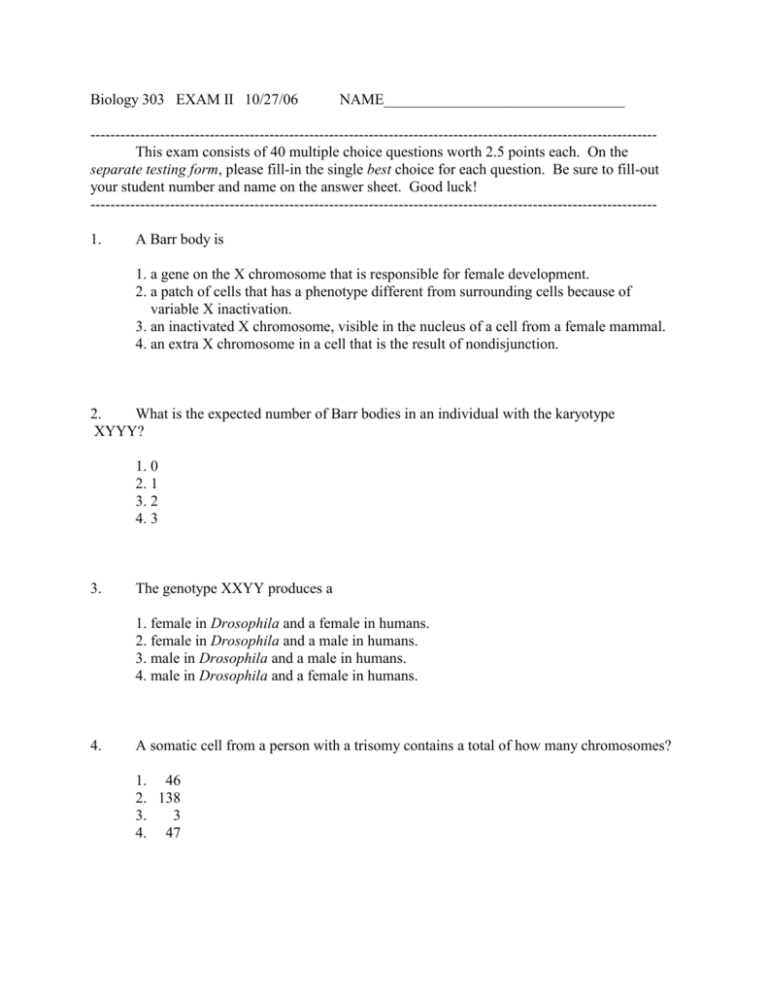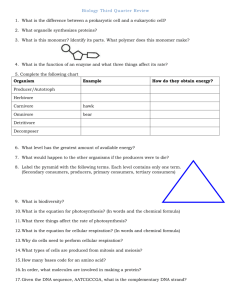Exam2-06f
advertisement

Biology 303 EXAM II 10/27/06 NAME________________________________ -----------------------------------------------------------------------------------------------------------------This exam consists of 40 multiple choice questions worth 2.5 points each. On the separate testing form, please fill-in the single best choice for each question. Be sure to fill-out your student number and name on the answer sheet. Good luck! -----------------------------------------------------------------------------------------------------------------1. A Barr body is 1. a gene on the X chromosome that is responsible for female development. 2. a patch of cells that has a phenotype different from surrounding cells because of variable X inactivation. 3. an inactivated X chromosome, visible in the nucleus of a cell from a female mammal. 4. an extra X chromosome in a cell that is the result of nondisjunction. 2. What is the expected number of Barr bodies in an individual with the karyotype XYYY? 1. 0 2. 1 3. 2 4. 3 3. The genotype XXYY produces a 1. female in Drosophila and a female in humans. 2. female in Drosophila and a male in humans. 3. male in Drosophila and a male in humans. 4. male in Drosophila and a female in humans. 4. A somatic cell from a person with a trisomy contains a total of how many chromosomes? 1. 46 2. 138 3. 3 4. 47 5. If the 2n number of chromosomes for an organism is 20, then a somatic cell from a triploid individual would have a total of how many chromosomes? 1. 10 2. 60 3. 21 4. 30 6. A balanced translocation 1. leads to the condition of “semisterility” even in the absence of any crossing-over. 2. leads to semisterility only if a crossover occurs between the translocated chromosomes during meiosis. 3. greatly increases the chances of nondisjunction. 4. has no consequence whatsoever since the genetic material is still balanced. 7. Familial Down syndrome is caused by: 1. a centric fusion. 2. position effect. 3. nondisjunction. 4. genomic imprinting. 8. A human female with Turner syndrome also expresses the X-linked trait hemophilia as did her father. Which of her parents underwent nondisjunction during meiosis, giving rise to the gamete responsible for the syndrome? 1. her mother 2. her father 3. both parents 4. technically speaking, there is not enough information to tell 9. Dosage compensation 1. must occur when one sex has more copies of a gene or genes than the other sex. 2. is a problem in species that have more autosomes than sex chromosomes. 3. cannot be directed by enhancing X-chromosome activity. 4. works in the same way in all animals. 10. The observation that a fly heterozygous for the double Bar allele and the wild-type allele (genotype = BD/B+) has a different phenotype than a fly that is homozygous for the Bar eye allele (genotype = B/B) serves as an example of the phenomenon known as 1. chaos 2. inversions 3. incomplete penetrance 4. position effect 11. The genetic material of most living things is 1. deoxyribonucleic acid. 2. ribonucleic acid. 3. RNA. 4. polysaccharide. 12. The basic structure of a nucleotide includes the following components: 1. amino acids. 2. base, sugar, phosphate. 3. phosphorous and sulfate. 4. all of the above. 13. Griffith's classic experiments with mice and Diplococcus pneumoniae 1. demonstrated that DNA is the genetic material. 2. demonstrated that the genetic material is not protein. 3. led to the discovery of the "transforming principle." 4. all of the above. 14. Which of the following clusters of terms accurately describes DNA as it is generally viewed to exist in prokaryotes and eukaryotes? 1. Double-stranded, parallel, (A+T)/(C+G)= variable, (A+G)/(C+T)=1.0 2. Single-stranded, antiparallel, (A+T)/(C+G)=1.0, (A+G)/C+T)=1.0 3. Double-stranded, antiparallel, (A+T)/(C+G)=variable, (A+G)/(C+T)=1.0 4. Double-stranded, antiparallel, (A+T)/C+G)=1.0, (A+G)/(C+T)=variable 15. Which of the following is a purine? 1. adenine. 2. cytosine. 3. thymine. 4. alanine. 16. Which one of the following is part of the Watson-Crick model for DNA? 1. DNA is triple-stranded. 2. the DNA helix is left-handed. 3. DNA consists of two strands of deoxynucleotides with the same polarity. 4. the number of purines equals the number of pyrimidines. 17. In DNA, each nitrogenous base is directly covalently attached to 1. a phosphate group. 2. a deoxyribose. 3. a ribose. 4. none of the above. 18. The two strands of a DNA helix are held together (to each other) by 1. covalent bonds. 2. hydrogen bonds. 3. phosphodiester bonds. 4. glycosidic bonds. 19. If one strand of a short DNA fragment has the sequence 5'-TTTTTTTT-3' then the other strand of DNA has the sequence 1. 5'-GGGGGGGG-3' 2. 5'-CCCCCCCC-3' 3. 3'-GGGGGGGG-5' 4. 5'-AAAAAAAA-3' 20. Reassociation kinetics experiments reveal that 1. DNA is very easy to melt. 2. DNA cannot be reannealed once melted. 3. the kinetics of reassociation says nothing about genomic structure. 4. eukaryotic genomes contain many repeated sequences. 21. Bacterial strain "A" has a genome with a Cot0.5 value of "Y" while bacterial strain "B" has a genome with a Cot0.5 value of "3Y". If the size of the genome for strain A is "X" base pairs, then the size of the genome of strain "B" is best approximated by: 1. 3X base pairs. 2. 2X base pairs. 3. X/2 base pairs. 4. X3 base pairs. 22. In the Meselson-Stahl experiment, what was the density distribution of the isolated DNA molecules two generations after shifting bacteria from "heavy" to "light" growth medium? 1. 100% of the molecules were of heavy density. 2. 50% were of heavy density, 50% were intermediate density. 3. 100% were of intermediate density. 4. 50% were of light density, 50% were intermediate density. 23. The enzyme that appears to be inappropriately expressed in cancer cells and helps to maintain the very ends of eukaryotic chromosomes is called 1. topoisomerase. 2. ligase. 3. telomerase. 4. terminase. 24. The fact that there is a problem maintaining the very ends of eukaryotic chromosomes during replication has to do with 1. the fact that eukaryotic chromosomes are linear. 2. the inability of DNA polymerases to initiate synthesis without a primer. 3. the restriction that DNA synthesis must occur in a 5' to 3' direction. 4. all of the above. 25. During replication of DNA, strand elongation proceeds 1. in a 5' to 3' direction on the leading strand, but in a 3' to 5' direction on the lagging strand. 2. in a 3' to 5' direction on the leading strand, but in a 5' to 3' direction on the lagging strand. 3. in a 5' to 3' direction on both the leading and lagging strands. 4. in a 3' to 5' direction on both the leading and lagging strands. 26. Which of the following is NOT an example of middle repetitive DNA? 1. SINES 2. LINES 3. satellites 4. VNTRs 27. Satellite sequences are usually found in 1. the centromeric region. 2. the coding region of genes. 3. the introns of genes. 4. bacterial genomes. 28. With regard to eukaryotic chromatin, when one visualizes "beads-on-a-string" each bead is actually a 1. gene. 2. histone. 3. nucleosome particle. 4. 30 nanometer fiber. 29. In eukaryotic chromatin, the next highest level of organization above "beads-on-a-string" is 1. the solenoid, or 30 nm fiber 2. chromatin loops. 3. the nuclear matrix. 4. the metaphase chromosome. 30. In Luria and Delbruck's classic experiments to distinguish between "spontaneous" versus "adaptive" mutation, 1. evidence for spontaneous mutation was produced. 2. evidence for adaptive mutation was produced. 3. evidence that DNA is the genetic material was produced. 4. all of the above. 31. A class of mutations which results in multiple contiguous amino acid changes in proteins is likely to be the following: 1. frameshift. 2. base analogue. 3. transversion. 4. transition. 32. Which statement is true? 1. DNA damage and mutation are the same thing. 2. DNA damage is defined as permanent change in the nucleotide sequence. 3. although DNA damage doesn't necessarily lead to mutation, when a mutation does occur it is always caused by DNA damage. 4. DNA damage can lead to mutation, but doesn't always. 33. An organism that is deficient in the biosynthesis of a particular important nutrient is called a(n) 1. prototroph. 2. auxotroph. 3. nutritroph. 4. dead organism. 34. A tautomeric shift 1. is typically induced by high-energy radiation. 2. occurs only in prokaryotes. 3. can lead to a transversion mutation. 4. can produce a transition mutation. 35. In mammals, DNA double-strand breaks may be repaired by 1. mismatch repair. 2. base excision repair. 3. nucleotide excision repair. 4. nonhomologous end-joining 36. Thymine dimers may be repaired by 1. photoreactivation and excision repair in humans. 2. excision repair but not by photoreactivation in humans 3. oxidative damage. 4. telomerase. 37. The simplest type of transposable elements in bacteria are known as 1. transposons. 2. insertion sequences. 3. Ds elements. 4. Ty elements. 38. The genetic code is: 1. ambiguous. 2. overlapping. 3. not degenerate. 4. not truly universal. 39. Which of the following is true? 1. every amino acid is coded for by a single codon. 2. there are more amino acids than there are codons. 3. every codon codes for an amino acid. 4. each codon in a gene codes for no more than one single amino acid. 40. Which of the following represent three posttranscriptional modifications often seen in the maturation of mRNA in eukaryotes? 1. 3'-capping, 5'-poly(A) tail addition, splicing. 2. removal of exons, insertion of introns, capping. 3. 5'-capping, 3'-poly(A) tail addition, splicing. 4. 5'-poly(A) tail addition, insertion of introns, capping. The End! QUESTION NUMBER 1 2 3 4 5 6 7 8 9 10 11 12 13 14 15 16 17 18 19 20 21 22 23 24 25 26 27 28 29 30 31 32 33 34 35 36 37 38 39 40 CORRECT ANSWER 3 1 2 4 4 1 1 1 1 4 1 2 3 3 1 4 2 2 4 4 1 4 3 4 3 3 1 3 1 1 1 4 2 4 4 2 2 4 4 3









